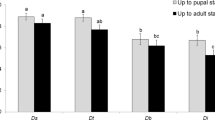Abstract
Three generations of the maize stalk borer, Busseola fusca (Fuller) per year were observed in maize fields in Southern Ethiopia. However, the third generation was not important on maize. The first generation developed on young maize plants during the wetseason (April–July). The second generation occurred in July and majority of larvae went into diapause from September to February while a small proportion pupated in the months of September and October and gave rise to a third generation. Pupation of the diapause larvae was observed in April.
Female moths from the first (non-diapause) generation laid significantly more eggs than those coming from a diapause generation. Longevity of these moths was also significantly longer than the diapause generation. Despite the indicated differences, female moths from both generations laid most of their eggs between the second and fifth nights after emergence. The number of eggs laid and rates of hatching declined with age of moths irrespective of generations.
Résumé
Trois générations du “maize stalk borerȝ, Busseola fusca (Fuller) par ans ont été observées dans des champs de maïs situés dans le sude de l’Ethiopie. Cependant, la troisième génération fut sans importance pour la recolte de maïs. La première génération s’est développée sur des jeunes plantes de maïs pendant la saison humide (avril-juillet). La deuxième génération est apparue en juillet et la majorité des larves sont entrées dans un état de diapause de septembre a février, tandis qu’une moindre proportion se nymhosaient aux mois de septembre et octobre, et produisaient une troisième génération. Les larves en diapause se sont nymphosées en avril.
Les femelles de la première génération (sans diapause) ont pondu plus d’oeufs que celles de la génération diapausante. Leur durée de vie etait aussi plus longue. Malgré les differences indiquées, les femelles des deux générations ont pondu la plupart de leurs oeufs entre la deuxième et la cinquième nuit suivant la mue imaginale. Le nombre d’oeufs produit et le taux d’éclosion diminue de façon continue avec l’age des femelles independemment de la génération.
Similar content being viewed by others
References
Assefa Gebre-Amlak (1989) Termination of diapause in the larvae of maize stalk borer, Busseola fusca (Fuller) in Awassa, Southern Ethiopia. J. Appl. Entomol. (in press).
Assefa Gebre-Amlak (1988) Development of maize stalk borer Busseola fusca (Fuller) in wild plants in Ethiopia. J. Appl. Entomol. (in press).
Assefa Gebre-Amlak, Sigvald, R. and Pettersson, J. (1988) The relationship between planting dates and the maize stalk borer, Busseola fusca (Fuller) infestation and damage on maize in Awassa (southern Ethiopia). Trop. Pest Manage, (in press).
Chapman R.F. (1982) The insect: Structure and function, 3rd Edition. Hodder and Stoughton. London.
Harris K.M. (1962) Lepidopterous stem borers of cereals in Nigeria. Bull. ent. Res. 53, 139–171.
Ingram W.R. (1958) Lepidopterous stalk borers associated with graminae in Uganda. Bull. entomol. Res. 49, 367–383.
Jepson W.F. (1954) A critical review of the world literature on the lepidopterous stalk borers of tropical graminaceous crops. Commonwealth Institute of Entomology.
Johannsson A.S. (1964) Feeding and nutrition in reproductive processes in insects. Symp. R. entomol. Soc. 2, 43–55.
Mally C.W. (1920) The maize stalk borer, Busseola fusca (Fuller). Bull. Dept. Agric. Sth. Africa No. 3.
Smithers C.N. (1959) Some recent observations on Busseola fusca (Fuller) (Lep:Noctuidae) in southern Rhodesia (Zimbabwe). Bull. entomol. Res. 50, 809–819.
Swain G. (1957) The maize and sorghum stalk borer, Busseola fusca (Fuller) in peasant agriculture in Tanganyika (Tanzania). Bull. entomol. Res. 48, 711–722.
Taylor D.E. (1982) Entomology note: The maize stalk borer. Zimbabwe Agric. J. 79, 119.
Unnithan G.C. (1987) Development and reproductive biology of the maize stalk borer, Busseola fusca (Fuller) (Lepid., Noctuidae). J. Appl. Entomol. 104, 172–179.
Usua E.J. (1967) Observations on diapause larvae of Busseola fusca. J. econ. Ent. 100, 1466–1467.
Usua E.J. (1968a) The biology and ecology of Busseola fusca and Sesamia species in southwestern Nigeria I. Distribution and population studies. J. econ. Entomol. 61, 830–833.
Usua E.J. (1968b) Temperature and relative humidity effects on the development of immature stages of the maize stem borer, Busseola fusca and Sesamia calamistis. J. econ. Entomol. 61, 1091–1093.
Usua E.J. (1970) Diapause in the maize stem borer. J. Econ. Entomol. 63, 1605–1610.
Usua E.J. (1973) Induction of diapause in the maize stalk borer, Busseola fusca. Entomol. Exp. Appl. 16, 322–328.
Van Rensburg J.B.J., Walters M.C. and Giliomee J.H. (1987) Ecology of maize stalk borer, Busseola fusca (Fuller) (Lepidoptera:Noctuidae). Bull. entomol. Res. 77, 255–269.
Walker P.T. (1960) Insecticide studies on the maize stalk borer, Busseola fusca in East Africa. Bull. ent. Res. 51, 321–351.
Author information
Authors and Affiliations
Rights and permissions
About this article
Cite this article
Gebre-Amlak, A. Phenology and Fecundity of Maize Stalk Borer Busseola fusca (Fuller) in Awassa, Southern Ethiopia. Int J Trop Insect Sci 10, 131–137 (1989). https://doi.org/10.1017/S1742758400010274
Received:
Revised:
Published:
Issue Date:
DOI: https://doi.org/10.1017/S1742758400010274




